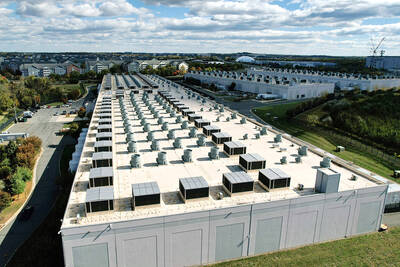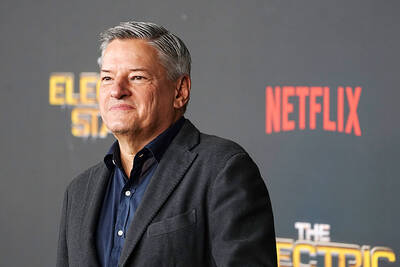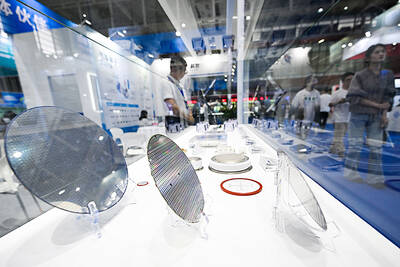With Mammoth’s 72 industrial fans, Swiss start-up Climeworks AG intends to suck 36,000 tonnes of carbon dioxide from the air annually to bury underground, vying to prove the technology has a place in the fight against global warming.
Mammoth, the largest carbon dioxide capture and storage facility of its kind, launched operations this week on a dormant volcano in Iceland. It adds significant capacity to the Climework’s first project, Orca, which also sucks the primary greenhouse gas fueling climate change from the atmosphere.
Just 50km from an active volcano, the seemingly risky site was chosen for its proximity to the Hellisheidi geothermal energy plant necessary to power the facility’s fans and heat chemical filters to extract carbon dioxide with water vapor.

Photo: Bloomberg
The carbon is then separated from the steam and compressed in a hangar where huge pipes crisscross.
Finally, the gas is dissolved in water and pumped underground with a “sort of giant SodaStream,” said Bergur Sigfusson, chief system development officer for Carbfix, which developed the process.
A well, drilled under a futuristic-looking dome, injects the water 700m down into volcanic basalt that makes up 90 percent of Iceland’s subsoil, where it reacts with the magnesium, calcium and iron in the rock to form crystals — solid reservoirs of carbon dioxide.
For the world to achieve “carbon neutrality” by 2050, “we should be removing something like 6 to 16 billion tonnes of CO2 per year from the air,” said Jan Wurzbacher, cofounder and cochief of Climeworks at the inauguration of the first 12 container fans at Mammoth.
“I quite strongly believe that a large share of these ... need to be covered by technical solutions,” he said.
“Not we alone, not as a single company. Others should do that as well,” he added, setting his start-up of 520 employees the goal of surpassing millions of tonnes by 2030 and approaching a billion by 2050.
Three years after opening Orca, Climeworks would increase capacity from 4,000 to 40,000 tonnes of carbon dioxide captured once Mammoth is at full capacity — but that represents just seconds of the world’s actual emissions.
According to the Intergovernmental Panel on Climate Change, the UN’s climate expert body, carbon removal technologies would be necessary to meet the targets of the 2015 Paris Agreement — but major reductions of emissions is the priority.
The role of direct air capture with carbon storage remains minor in the various climate models due to its high price, and its deployment at a large scale depends on the availability of renewable energy.
Climeworks is a pioneer with the two first plants in the world to have surpassed the pilot stage at a cost of about US$1,000 per tonne captured. Wurzbacher expects the cost to decline to US$300 in 2030.
More than 20 new infrastructure projects, developed by various players and combining direct capture and storage, should be operational worldwide by 2030 with a capacity of about 10 million tonnes.
“We need probably around US$10 billion to proceed over the next decade to deploy our assets” in the US, Canada, Norway, Oman and Kenya, said Christoph Gebald, Climeworks cofounder and cochief, 10 times what the company has already raised.
“When I’m standing now at Orca I think: ‘Oh this looks like a little bit like Lego bricks.’ It’s a tiny thing compared to Mammoth,” Wurzbacher said.
Lego bought carbon credits generated by Climeworks for every tonne of carbon dioxide stored.
The credits are a way for making the solution known to the general public, said Gebald, who has not ruled out selling credits to “big polluters” as well.
Critics of the technology point to the risk of giving them “license to pollute” or diverting billions of dollars that could be better invested in readily available technology such as renewable energy or electric vehicles.
Climeworks said it targets “incompressible” emissions, after reduction.
The recipe is complex: optimize costs without competing with the growing need for renewable energy, more innovation, public and private funding, with storage infrastructure to follow.
“We are currently doing a pilot testing of using seawater for injection,” Carbfix chief scientist Sandra Osk Snaebjorndottir said.
That procedure would allow the use of seawater for the mineralization of carbon emissions, near a port built by the Icelandic company to receive carbon dioxide from other countries.

The demise of the coal industry left the US’ Appalachian region in tatters, with lost jobs, spoiled water and countless kilometers of abandoned underground mines. Now entrepreneurs are eyeing the rural region with ambitious visions to rebuild its economy by converting old mines into solar power systems and data centers that could help fuel the increasing power demands of the artificial intelligence (AI) boom. One such project is underway by a non-profit team calling itself Energy DELTA (Discovery, Education, Learning and Technology Accelerator) Lab, which is looking to develop energy sources on about 26,305 hectares of old coal land in

Taiwan’s exports soared 56 percent year-on-year to an all-time high of US$64.05 billion last month, propelled by surging global demand for artificial intelligence (AI), high-performance computing and cloud service infrastructure, the Ministry of Finance said yesterday. Department of Statistics Director-General Beatrice Tsai (蔡美娜) called the figure an unexpected upside surprise, citing a wave of technology orders from overseas customers alongside the usual year-end shopping season for technology products. Growth is likely to remain strong this month, she said, projecting a 40 percent to 45 percent expansion on an annual basis. The outperformance could prompt the Directorate-General of Budget, Accounting and

Netflix on Friday faced fierce criticism over its blockbuster deal to acquire Warner Bros Discovery. The streaming giant is already viewed as a pariah in some Hollywood circles, largely due to its reluctance to release content in theaters and its disruption of traditional industry practices. As Netflix emerged as the likely winning bidder for Warner Bros — the studio behind Casablanca, the Harry Potter movies and Friends — Hollywood’s elite launched an aggressive campaign against the acquisition. Titanic director James Cameron called the buyout a “disaster,” while a group of prominent producers are lobbying US Congress to oppose the deal,

Two Chinese chipmakers are attracting strong retail investor demand, buoyed by industry peer Moore Threads Technology Co’s (摩爾線程) stellar debut. The retail portion of MetaX Integrated Circuits (Shanghai) Co’s (上海沐曦) upcoming initial public offering (IPO) was 2,986 times oversubscribed on Friday, according to a filing. Meanwhile, Beijing Onmicro Electronics Co (北京昂瑞微), which makes radio frequency chips, was 2,899 times oversubscribed on Friday, its filing showed. The bids coincided with Moore Threads’ trading debut, which surged 425 percent on Friday after raising 8 billion yuan (US$1.13 billion) on bets that the company could emerge as a viable local competitor to Nvidia